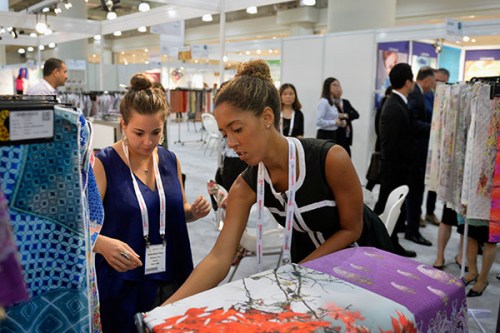
Two exhibitors display their company's textile products during the international textile and apparel sourcing show at the Jacob K. Javits Convention Center in New York. (Photo/Xinhua)
The price of high-quality cotton in China is about 30 percent more than elsewhere, which caused fiber processing in China to drop by 26 percent last year, the council said.
China customs figures showed that the country's textile and apparel exports from January to April decreased 2.5 percent to $81.9 billion, compared with the same period in 2014. In April, the export figure plunged 16.4 percent.
BMI Research forecast that in 2015, India, Bangladesh and Vietnam will be the main beneficiaries of the decline in the Chinese textiles business. Those countries already have experienced a sharp increase in cotton and textile exports, due to favorable government policies, a young demographic profile and competitiveness due to a low-cost production base.
The good news for Chinese textile makers might be that the US market offers opportunity.
Zhang Qiyue, Chinese consul general in New York, said that China's textile and fabric industries have seen a rise in business with the US. From 2000 to 2014, bilateral textile and apparel commerce grew from $6.2 billion to $46 billion.
Exports from China to the US increased slightly from January to May. In April, exports of textiles and apparel to the US increased by 7.8 percent, according to China's National Bureau of Statistics.
As the euro is sliding to a nine-year low against the dollar and European economies are slowing down, the US market is taking on more significance for Chinese textile and apparel companies.
"More Chinese brands are on display this year. Most of them used to focus on the domestic market but are now focusing on the US market," Sun Ruizhe, vice-chairman of the China National Textile and Apparel Council, said. "They are supposed to offer more good options for the US business partners."
Jiangsu Sainty Fortune, a state-owned company, brought its winter collection to the New York trade show. "As Europe's economy is going down ... and the US economy is picking up, the market is more significant for us," Wu Hui, assistant general manager at Jiangsu, said. "The US and Canada now contribute more than half of our business."
Lei Shengzu, manager of China Textiles (Shenzhen) Co, said he is planning to set up a New York office by the end of 2015.
"It is supposed to better cater to the US market, which is expected to expand by 20 percent," Lei said. "Now orders from the US are still in small quantity, and we are striving to seek and develop a long-term partnership in the US market so as to get big orders."
The company also has invested more in research and development and set up a department to focus on innovation.
"The role of the department is growing increasingly important in the company," Lei said. "Previously, clients loved to bring some product samples of big brands and asked them to copy and sell at a lower price. We were very negative and passive, as we always had to wait for others' products."
Chinese companies are also starting to pay more attention to research and development. Instead of copying the big brands' designs, they are trying to develop new products to lift their own label awareness.
Although so far no Chinese company has succeeded in building an internationally renowned brand, industry professionals have started to work on creating a high-end label in the overseas market. "We have to upgrade services and offer new products more often to retain customers," Deng Zhijuan, an officer from Shanghai-based High Fashion Textile and Manufacturing Co, said.
The wide range of products and innovative material has increased raised in fabrics made in China, as designers are eager for inspiration from new designs.
"I have got many great ideas when walking past booths," said Vanessa Andrews, an independent designer. "The products are beautiful, and I've found some locket-like buttons, which would be suitable for my next collection."
Boris Litvinov, CEO of Active Line Corp, an apparel and fabrics business, said he has two suppliers from the mainland and four from Taiwan.
"For us, quality is more important than price," he said. "In recent years, the quality of Chinese products is getting much better.
"What China doesn't have now is the quality consistency from order to order, which is the key for Chinese suppliers to opening up the US market," he said.


















































